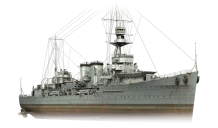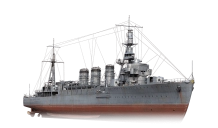
Premium Ship:
Cost:
- Silver:
Gold:
Hit Points:
Weight Limit:
WoWs Cruiser Kuma
Player rating
Overview:
- After learning about the characteristics of the Omaha-class ships, the Japanese engineers prepared a project for a large cruiser with increased combat power. It was planned for the ship to combine the functions of a destroyer leader and a scout. An increase in displacement was used to strengthen the ships propulsion and raise the number of main battery guns to seven. During World War II, Kuma participated in the landings in the Philippines, in battles in New Guinea, and patrolled the waters of the Dutch East Indies. On January 11, 1944, Kuma was torpedoed by submarine HMS Tally-Ho in the Strait of Malacca. The cruiser caught fire and sank.
Cost:
- Silver:
Gold:

















